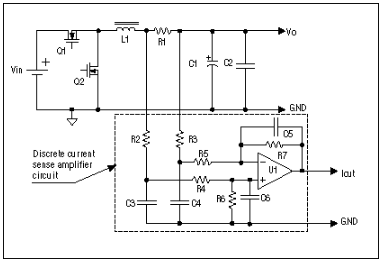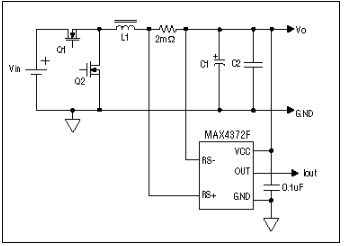
Current sharing between DC/DC converter modules is a very important system parameter to ensure reliable operation. In recent years, the current sharing tolerance has been tightened to 10% of the rated output current, which presents a challenge in designing discrete current detection circuits, as shown below, especially in high output current power supplies.
This is because A small value current detection resistor (less than or equal to 2mΩ) is required to minimize power consumption, resulting in a small current-voltage conversion, which means ≤2 mV/A. Due to operational amplifier (U1), input offset voltage and external component tolerance, it is difficult for traditional discrete current detection amplifiers to meet the requirements of total tolerance.
An example of an op-amP-based circuit for 20A output current applications is also shown. Assuming R1 = 2mΩ, the maximum input offset voltage of U1 is 3mV. Since the 2mV voltage drop at both ends of R1 represents the 1A output current, the 3mV off-balance voltage represents a 7.5% error in the worst case (due to off-balance alone), which is generally unacceptable. Low input offset operational amplifiers with precision resistors (tolerance ±0.1%) reduce error but significantly increase cost.
Schematic diagram of a typical discrete current detection amplifier

Another problem associated with discrete current detection circuits is the addition of manufacturing for assembling external components. A sophisticated, low-cost, space-saving current detection IC is needed to replace discrete circuits.
The MAX4372 is packaged in a miniature SOT23-5 package to provide a low-cost, space-saving, and high-precision solution for high-edge and high-current detection. The device is available in three gain versions (20V/V, 50V/V, and 50V/V) and is powered by a single power supply from +2.7V to +28V with a power consumption of only 30μA.
The MAX4372 is designed and adjusted for input offset voltage and gain to provide 0.18% full scale accuracy with 100mV Vsense input. This is equivalent to only 0.18mV of the input offset voltage, assuming that the error is entirely due to the input offset voltage.
If MAX4372 is applied to the previous example, the total tolerance drops to 0.45% (0.18mV/40mV). The user can set the full scale current reading by selecting the device with the desired voltage gain (T, F, or H) and selecting the appropriate external detection resistance. This capability provides a high level of integration and flexibility, resulting in a simple and compact current detection solution. MAX4173 provides a higher bandwidth current detection solution. Figure 2 shows a typical circuit for 20A current detection applications.
Typical 20A current detection applications using MAX4372F
